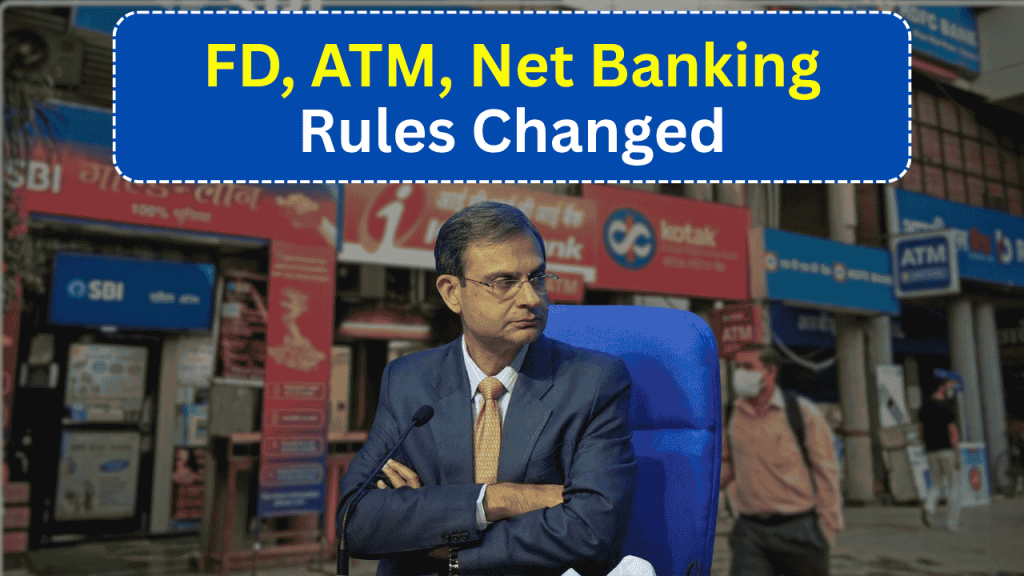
The Indian banking sector has implemented several significant changes effective May 2025, affecting Fixed Deposits (FDs), ATM usage, and Net Banking services. These modifications aim to enhance security, improve customer experience, and adapt to the evolving digital landscape. While some changes might require adjustment from customers, many bring substantial benefits, particularly for regular users of digital banking services and those maintaining higher account balances.
New Fixed Deposit (FD) Rules and Interest Rate Changes
Fixed Deposit schemes across major Indian banks have undergone notable revisions, with many institutions introducing tier-based interest rates that reward customers with higher deposits.
Key Changes to FD Rules
| Bank | Previous Top FD Rate | New Top FD Rate | Special Features |
|---|---|---|---|
| HDFC Bank | 7.10% | 7.25% | Higher rates for 10-21 month tenure |
| Yes Bank | 7.75% | 7.98% | Premium rates for 12-24 month deposits |
| SBI | 7.10% | 7.30% | Senior citizens get additional 0.50% |
| ICICI Bank | 7.00% | 7.05% | Tiered rates based on deposit amount |
| Indian Bank | 7.30% | 7.50% | Special schemes for regular depositors |
The revised FD structure introduces several customer-friendly features:
- Tier-based interest rates: Customers with larger deposits now qualify for preferential interest rates, with incremental benefits starting from ₹3 lakh deposits.
- Special tenure options: Banks have introduced optimized tenure periods that offer peak interest rates, typically falling in the 12-24 month range.
- Senior citizen benefits: Enhanced premiums for senior citizens, with some banks increasing the additional interest rate from 0.35% to 0.50%.
- Digital FD bonuses: Additional rate benefits (0.10-0.15%) for FDs opened through digital channels rather than at physical branches.
For customers looking to maximize returns, these new rules provide opportunities to strategically place deposits across different tenures and amounts to optimize interest earnings.
Modified ATM Transaction Rules
ATM usage policies have undergone significant changes, affecting withdrawal limits, transaction fees, and security features.
Revised ATM Transaction Fees and Limits
| Transaction Type | Previous Rule | New Rule | Impact |
|---|---|---|---|
| Free withdrawals (own bank) | 5 per month | 5 per month | No change |
| Free withdrawals (other banks) | 5 per month | 3 per month | Reduced free transactions |
| Transaction fee (after free limit) | ₹21 per transaction | ₹23 per transaction | Increased fee |
| Daily withdrawal limit | Varied by bank | ₹50,000 standardized | Uniform limit across banks |
| Non-financial transactions | Free unlimited | Counted in transaction limit | Limited free services |
The new ATM regulations have introduced several important changes:
- Reduced free transactions: The number of free withdrawals from other banks’ ATMs has been reduced from five to three per month, particularly affecting customers who frequently use ATMs outside their bank’s network.
- Increased transaction fees: After exhausting the free transaction limit, customers will now pay ₹23 per transaction, up from the previous ₹21, representing a 9.5% increase.
- Enhanced security measures: The Positive Pay System (PPS) has been introduced for cheque payments exceeding ₹50,000, requiring customers to verify details before processing.
- Standardized withdrawal limits: A uniform daily cash withdrawal limit of ₹50,000 has been set across all banks, creating consistency in the banking system.
These changes aim to encourage digital transactions while covering the rising costs of maintaining ATM infrastructure. Customers who primarily use their own bank’s ATM network or prefer digital payment methods will be less affected by these changes.
Enhanced Net Banking Security and Features
The most substantial improvements have come in the realm of Net Banking, with significant security enhancements and new customer-centric features.
Major Net Banking Improvements
| Feature | Previous System | New Implementation | Benefit |
|---|---|---|---|
| Authentication | Password-based | Multi-factor with biometrics | Enhanced security |
| Transaction monitoring | Basic alerts | AI-powered fraud detection | Proactive protection |
| User interface | Standard design | Personalized dashboard | Improved user experience |
| Mobile integration | Limited features | Full feature parity | Seamless cross-platform use |
| Customer support | Email and phone | 24/7 AI chatbot assistance | Faster issue resolution |
The revamped Net Banking services offer several notable advantages:
- Advanced security protocols: Implementation of multi-factor authentication, including biometric verification and device recognition, significantly reducing unauthorized access risks.
- AI-powered fraud detection: Real-time transaction monitoring with artificial intelligence algorithms that flag unusual patterns and potential fraud attempts before transactions complete.
- Personalized user experience: Customizable dashboards that prioritize frequently used features and provide personalized financial insights based on spending patterns.
- Enhanced UPI services: Streamlined UPI payment system with automatic beneficiary verification and instant transaction confirmation.
- Inactive account protection: New safeguards for dormant accounts, including automatic deactivation of UPI IDs linked to inactive mobile numbers to prevent fraudulent use.
These security improvements come in response to the growing sophistication of cyber threats targeting the banking sector. The enhancements follow guidelines from the Reserve Bank of India to strengthen the digital banking infrastructure.
Special Benefits for Premium Account Holders
Customers maintaining higher account balances or using multiple banking services will receive several additional benefits under the new rules.
Premium Account Advantages
| Account Type | Minimum Balance | Special Benefits |
|---|---|---|
| Standard | ₹5,000-₹10,000 | Basic banking services |
| Premium | ₹25,000-₹1 lakh | Preferential rates, reduced fees |
| Privilege | ₹2 lakh+ | Relationship managers, zero fees |
| Wealth | ₹5 lakh+ | Financial advisory, global services |
Premium account holders will enjoy several exclusive benefits:
- Waived transaction fees: Complete exemption from ATM transaction charges regardless of usage frequency or location.
- Preferential FD rates: Additional interest rate premiums of 0.10% to 0.25% above standard rates.
- Dedicated relationship managers: Personalized banking assistance for high-value customers.
- Enhanced digital services: Priority processing for online transactions and dedicated customer support channels.
- Cross-product benefits: Discounted rates on loans, reduced processing fees, and preferential credit card features.
These tiered benefits encourage customers to consolidate their banking relationships and maintain higher balances, creating a win-win situation for both banks and customers.
Impact on Different Customer Segments
The new banking rules will affect various customer segments differently:
Urban Professional Account Holders
Urban professionals who primarily use digital banking services will benefit from enhanced security features and improved user interfaces. The reduction in free ATM transactions will have minimal impact on this segment, as they typically rely on UPI and online transfers for most transactions.
Rural and Semi-Urban Customers
Customers in rural and semi-urban areas who depend more heavily on ATM services might face increased costs due to the reduction in free transactions. However, banks are planning to expand their ATM networks in underserved areas to mitigate this impact.
Senior Citizens
Senior citizens will benefit significantly from the increased FD interest rates and additional premiums. Many banks have also introduced simplified digital banking interfaces specifically designed for elderly customers, making online banking more accessible.
High-Value Customers
Customers maintaining substantial balances will experience the most benefits from the new rules, with preferential rates, fee waivers, and personalized services enhancing their banking experience.
Preparing for the New Banking Environment
To make the most of these changes and minimize potential inconveniences, customers should consider the following steps:
- Review account types: Evaluate whether your current account type aligns with your banking needs and consider upgrading if beneficial.
- Optimize ATM usage: Plan ATM withdrawals to stay within the free transaction limits and consider using your own bank’s ATMs whenever possible.
- Explore digital alternatives: Familiarize yourself with UPI, mobile banking, and online payment options to reduce dependence on ATM transactions.
- Update security settings: Ensure your mobile number and email are correctly registered with your bank and set up additional security features offered in Net Banking.
- Reassess FD strategies: Review existing FDs and consider restructuring them to take advantage of the new interest rate tiers and special tenure options.
FAQs on New Banking Rules
Q: Will the reduction in free ATM transactions affect all bank customers equally? A: No, premium account holders at many banks will continue to enjoy unlimited free ATM transactions, while standard account holders will be limited to three free transactions at other banks’ ATMs.
Q: How can I avoid paying higher fees under the new ATM rules? A: Plan larger, less frequent withdrawals at your own bank’s ATMs, use UPI and digital payment options for everyday transactions, and consider maintaining higher account balances to qualify for fee waivers.
Q: Are the new Net Banking security features mandatory for all users? A: Yes, most security enhancements like multi-factor authentication are mandatory, but customers can choose which biometric verification methods they prefer to use.
Q: How frequently will FD interest rates be revised under the new system? A: While banks can change rates at their discretion, most institutions have indicated they will review and potentially adjust FD rates quarterly to remain competitive.
Conclusion
The banking sector changes implemented in May 2025 represent a significant shift toward digital-first, security-focused banking services in India. While the reduction in free ATM transactions may require adjustment from some customers, the enhanced security features, improved digital experiences, and preferential rates for loyal customers create an overall more robust and customer-centric banking ecosystem.
For customers willing to embrace digital banking and strategically manage their accounts, these changes offer numerous opportunities to enhance their banking experience while enjoying greater security and potentially higher returns on their deposits. As the banking landscape continues to evolve, staying informed and proactively adapting to new features and policies will be key to maximizing the benefits of these changes.













